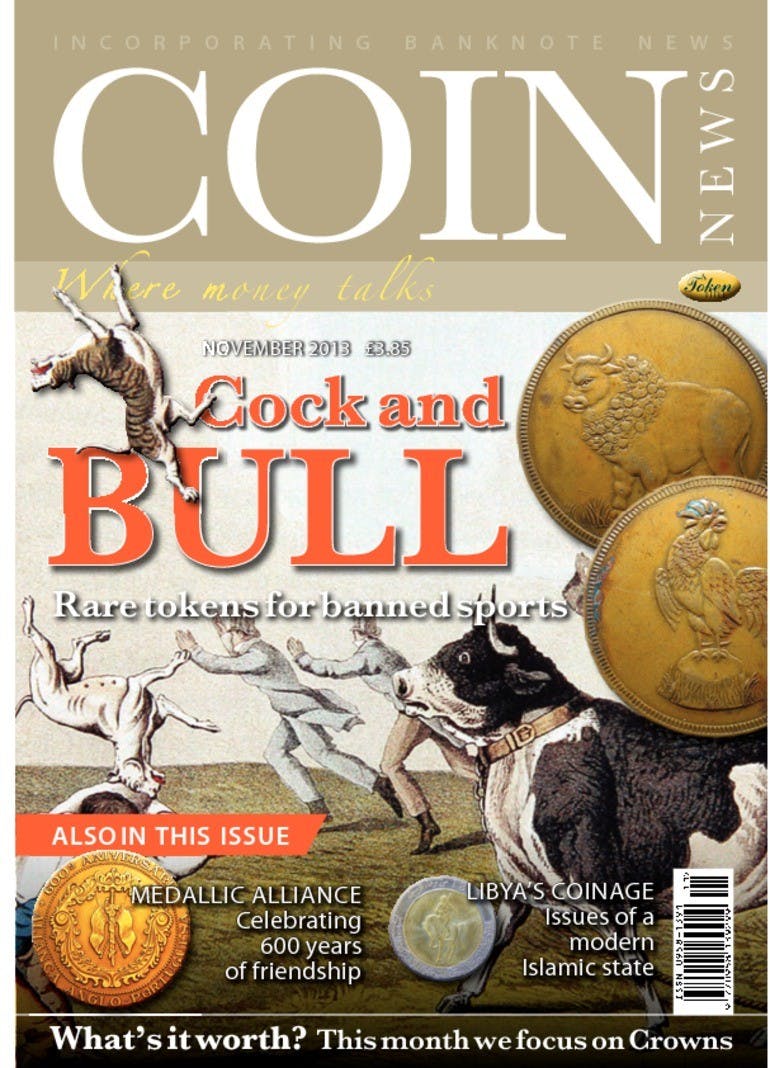Cock and Bull
Volume 50, Number 11, November 2013
Making the grade MENTION grading and people start to twitch. Every one of us has a horror story or two to tell about a coin they’ve bought at one grade only to discover no-one else agrees with the grading at all, or how they’ve bought a coin only to drop it, scratch it or watch it tarnish because it was stored incorrectly. The grading system is central to our hobby and yet is massively contentious; rarely will two collectors or dealers agree and often this causes real problems especially when the difference in grades can mean a difference in value of hundreds, if not thousands, of pounds. Military medals are different, collectors like them to be in a decent condition but, as a rule, it is the recipient not the state of the medal itself that determines value. Indeed the odd nick, dent, scratch or over-zealous polishing often adds to the story of a medal group rather than detracts from it—try saying that to a coin collector! Numismatists are obsessive about their grading, the slightest flaw or blemish can seriously affect a coin and for years the debate has raged about just how coins should be graded. As a rule the British and Europeans prefer the Fine (F) to Fleur de Coin (FDC) grading system with F being defined as fairly worn, well circulated and FDC defined as perfect as a coin can be. The American system breaks that down into the Sheldon Scale (first introduced by William H. Sheldon in his work on American Large Cents in 1949 and later modified in the 1970s) where an uncirculated coin is given a number between 60 and 70 (usually with the prefix MS to denote Mint State), EF coins are given numbers between 58 and 60 and so on down to 30 (which confusingly equates to an F coin but has the prefix VF). There are lower numbers/grades but few coins that are classed as such are worth the attention of a collector and so frequently aren’t catalogued. The US scale allows for more variety inasmuch that an MS68 coin might be classed as an FDC coin in the UK but might have one or two very slight bag marks, invisible to the naked eye but enough, when seen under a glass, to ensure it doesn’t make the top MS70 grade. In recent years a third grading system has been introduced by the Coin Grading Service (CGS UK) that aims to have a simple numerical scale from 1–100 with, logically 100 being the absolute best a coin can be. It’s an easy enough system to use and very straightforward but, of course, doesn’t relate directly to either the UK standard or the American systems! I notice in the magazine this month that CGS have produced a rather useful chart showing how their grading system sits with the more recognised ones—something I may well borrow (with their permission, of course) for the next COIN YEARBOOK—if only to help British collectors who, in this increasingly smaller global village, find themselves buying coins from the US and having to work out what MS61 actually means! That, of course, is one of the major issues—as it becomes easier and easier to buy from abroad so knowledge of another country’s grading system becomes all the more important. Do the French have the same ideas as the Russians? Do the Australians consider the same factors as the Americans? Do the British rate certain things as highly as the Germans and do the Italians worry about some factors more than the Irish? The solution would be to have a global system, something everybody could agree on but, let’s be honest, that’s unlikely to happen anytime soon—it is hard enough to get two individual dealers or collectors to agree absolutely on a grade so there isn’t much chance that different countries are going to! Even the slabbing processes, so popular in the States and increasingly found over here (CGS again!), don’t completely solve the problem; after all just because an encapsulation company says a coin is MS68/CGS 95/FDC that doesn’t mean every collector will agree—and that is the crux of it. Yes, grading is important, yes, I understand why it can change the value of a coin hugely but ultimately if we aren’t able to all agree (and we aren’t) on exactly what that grade is then surely there has to be another way of looking at things? There is—it is called subjectivity, it involves you as a collector looking at a coin and deciding whether you like it or not. If you do, and you want to spend the money the dealer is asking then buy it. If it appeals to you, if you really want it then that’s OK, don’t get too hung up on whether it is a 95 or a 96 an MS60 or MS62. You should be collecting because you want the coins, not with one eye on making a profit in the future. Grading is important, of course it is, and grading systems are very, very useful but if you like something don’t worry too much about what other people think—it is your hobby, your collection and missing out on a coin you like because someone else doesn’t agree with your appraisal of it seems a shame. After all this is meant to be fun!
Order Back Issue
You can order this item as a back issue, simply click the button below to add it to your shopping basket.

